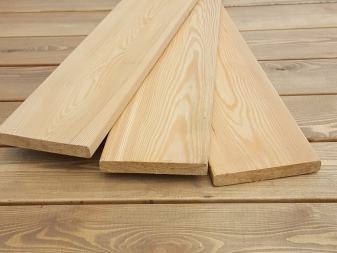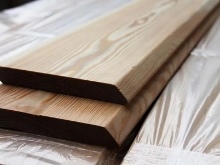All about planken mounting

Planken allows you to sheathe the walls, giving them an aesthetic appearance. At the same time, this finish protects well from negative natural influences. Thanks to such cladding, the facade will look beautiful for a long time, while keeping heat well. The use of planken is quite wide not only as a decoration, but also for the creation of gazebos, verandas, awnings, decks, berths and in landscape design.


Peculiarities
A facade board called planken can successfully replace a bar, lining or block house. This material is widely used in various construction and finishing works. Of course, there are tasks for which planken is best suited. For example, installing a plank on the facades of buildings will add warmth and a chic look to them.
You can make a wonderful fence, playground, pieces of furniture from it. It should be noted that the material is resistant to water and various pests. And it is often used in the construction of open verandas, gazebos, terraces, for finishing ceilings and railings.
Despite its thin profile, the planken has the same characteristics as a deck board. This allows it to be used for flooring.


For the manufacture of planken, larch, pine or polymer composite is most often taken. Of course, larch will be better than others in terms of characteristics. A strong and durable material is obtained from it, which also provides noise damping. Pine contains substances that prevent the spread of rot and fungi.
Plankening of buildings requires that the surface is first treated with antiseptic agents. And it is also important for the reliability of fastening to make the frame correctly. Moreover, it is possible to lay materials for insulation and sound insulation under it. Experts recommend laying the boards horizontally in order to reduce material consumption, and this will also help to make the surface look as aesthetically pleasing as possible.


There are several types of planken.
- Straight, which is also called classic. Differs in straight edges. It is important to mount it with a technological gap.
- Beveled, in which the faces are rounded and cut at a certain angle (35-70 degrees).
- With groovesoverlapped.



Fasteners overview
Professionals recommend choosing a stainless steel mount. It is able to fully recoup its considerable cost. When choosing steel products, it is important to look for a zinc coating. It should be clarified that simple painting is not a reliable metal protection.
- Snake ("wave") great for attaching a beveled plank, but can also be used for a straight view. The name of the fastener comes from a zigzag plate. This type of fastening has subspecies, for example, "Atlant", "channel" and others. It should be clarified that for this type you do not need anything except a pencil, a ruler and a screwdriver. Of the features of the fasteners, it is worth noting the use for vertical and horizontal fastening.
The plus of the snake is that it provides a reliable fixation and has special stoppers that prevent temperature and other deformation of the planken.

- PLANfix is a metal bar that is bent at right angles. At the same time, on one of its sides there is a sharp spike for fastening to the wall. Each side of the strip is also provided with holes for fixing. It is mainly used for rectangular planks without grooves.When installing this fastener, you can use nails or self-tapping screws. Due to the resulting gap, technical ventilation is provided.

- "Duet-facade" is an advanced snake type fastener. It is a composite strip that is corrosion resistant and does not collect moisture. Suitable for all types of planks and various surfaces, including horizontal decks, ceiling structures and ventilated facades. It is convenient to work with this fastener, since it is equipped with a special stop. Among the many advantages, it is worth noting resistance to fungi and various pathogenic microorganisms. It should be noted that the "duet-facade" allows you to compensate for the thermal expansion of materials. In this form, the most popular were the models "Duet-70" and "Duet-90" for their versatility.

- "Crab" suitable for tiling work with a board that has end grooves. As a rule, if the "crab" is of high quality, then it will be made of galvanized metal. Moreover, its thickness will be at least one millimeter. The fasteners have two hooks in the shape of the letter "L", which fit into the groove and are the fixer of the front board to the facade. It should be noted that this type is considered the most versatile, since it can be combined with any type of planken. For example, in the standard version, the fastener can be used for boards in which the depth of the bottom groove is 8 millimeters.

- Omega is like a crab mount, but has a simpler configuration and a larger gap between the boards. Suitable only for slotted planks. This fastener is highly reliable and suitable for all types of trees. It is a curved plate with two hooks and a hole for fixing.


- Bridge features a long service life and easy installation. Suitable for aggressive environments and high humidity.
It is worth noting that the use of this fastener significantly speeds up the work.

- Key is one of the simplest fasteners. There are various options ("Richard Babij", "Gvozdek") that are suitable for boards of different types and profiles. In appearance, it resembles an ordinary key, which has a hole in the cap for a self-tapping screw. Thanks to the attachment of this type, two boards can be sewn to the frame at once.

- "Cobra" only suitable for straight planken, which is made from soft wood. As a rule, the fittings have 2 bases, which are located at an angle and directed in opposite directions. One of them has a spike 11 mm long, and the other has holes. Suitable for horizontal and vertical mountings.

- "Cat" is one of the tenon fasteners that provides quick fixation. Well suited for straight planken from any wood. The fastener is equipped with a stopper, a hole and two studs pointing in different directions. This provides a secure fit and ventilation gap.

- Duplex - hidden fasteners, which are two plates and fittings that provide a lock connection. Fastening occurs due to the oval groove and fixing elements. This type of fastener is suitable for suspended ceilings, facades and other works where reliable fastening is important.

- "Kleimer" refers to hidden fasteners that are made of galvanized or steel. Can be used with any type of planken. This fastener includes a base, tongue, nail holes or staple bracket. Of the advantages, it is worth noting the ease of use on both horizontal and vertical surfaces.

Installation methods
The easiest way to mount the planken is when you have clear instructions at hand. The laying technology is carried out in two ways: open or hidden (closed). If we consider the installation step by step, then it will look like this:
- the imposition of the lathing;
- laying a layer of insulation;
- installation of planken.
Thus, you can simply and quickly lay the facade plank with your own hands, as a result of which you get a beautiful building with a ventilated facade.

Open
This installation method is simple. It implies that the boards must be fastened with self-tapping screws or screws from the front side of the facade. Of the advantages, it is important to note reliability, since any natural influences will not tear off the plank, attached in an open way. However, in this case, the finish will not look aesthetically pleasing enough, since the heads of the fasteners will be visible on the surface. And also, this method should not be used for larch, so that crevices do not appear on the tree.

Hidden
For this fastening method it is necessary to use special fasteners, such as a snake, "crab", key, PLANfix, bridge, "kleimer" other. An option is selected depending on the type of plank (straight, beveled, with grooves) and the type of fastening (vertical, horizontal).
Planken is prepared for the closed method, starting with the layout of the boards on a flat surface along the height of the base, which will be sheathed. After that, the dimensions of the lathing structure are applied, to which the plank will be attached. Metal planks are laid on the boards so that they protrude slightly (about 1 cm) beyond their edge. At the end of the laying and adjusting work, the strips must be fixed with self-tapping screws.

Recommendations
Professionals recommend choosing a dark-colored windscreen and a black snake fastener for a straight-type planken, preferably made of plastic. This is due to the fact that the galvanized coating will flicker in the gaps. For in order for the casing to serve for many years and not lose its qualities, you should use self-tapping screws that have an anti-corrosion coating. In this case, darkening and rust stains will not form on the boards.
When calculating the required amount of fasteners that will be needed to finish the surface of the planken, it is important to consider some criteria. For example, you need to know the characteristics of boards, fittings, as well as the area of the surface to be sheathed. It is best to use a special formula for this.

In the next video, you will find the secrets of installing a plank on hidden fasteners.












The comment was sent successfully.